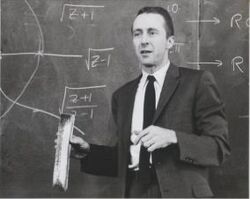Biography:George F. Carrier
George Carrier | |
|---|---|
 At Harvard University, ca. 1952 | |
| Born | Millinocket, Maine |
| Died | March 8, 2002 (aged 83) Boston, Massachusetts |
| Nationality | American |
| Alma mater | Cornell University |
| Known for | Fluid dynamics Combustion Tsunamis |
| Awards | Otto Laporte Award (1976) Theodore von Karman Medal (1977) Timoshenko Medal (1978) Fluid Dynamics Prize (APS) (1984) National Medal of Science (1990) |
| Scientific career | |
| Fields | Mathematics |
| Institutions | Harvard University Brown University |
| Thesis |
|
| Doctoral advisor | J. Norman Goodier |
| Doctoral students | |
George Francis Carrier (May 4, 1918 – March 8, 2002) was an engineer and physicist, and the T. Jefferson Coolidge Professor of Applied Mathematics Emeritus of Harvard University. He was particularly noted for his ability to intuitively model a physical system and then deduce an analytical solution. He worked especially in the modeling of fluid mechanics, combustion, and tsunamis.
Born in Millinocket, Maine, he received a master's in engineering degree in 1939 and a Ph.D. in 1944 from Cornell University with a dissertation in applied mechanics entitled Investigations in the Field of Aeolotropic Elasticity and the Bending of the Sectorial-Plate under the supervision of J. Norman Goodier.[1] He was co-author of a number of mathematical textbooks and over 100 journal papers.
Carrier was elected to the American Academy of Arts and Sciences in 1953,[2] the United States National Academy of Sciences in 1967, and the American Philosophical Society in 1976.[3] In 1990, he received the National Medal of Science, the United States' highest scientific award, presented by President Bush, for his contributions to the natural sciences.[4]
He died from esophageal cancer on March 8, 2002.
Carrier's Rule
Carrier is known for "Carrier's Rule",[5] a humorous explanation of why divergent asymptotic series often yield good approximations if the first few terms are taken even when the expansion parameter is of order one, while in the case of a convergent series many terms are needed to get a good approximation: “Divergent series converge faster than convergent series because they don't have to converge.”
References
Notes
- ↑ Abernathy FH and Bryson AE (2007) George F. Carrier, in "Memorial Tributes: National Academy of Engineering", Vol. 11, 46-51.
- ↑ "George Francis Carrier" (in en). https://www.amacad.org/person/george-francis-carrier.
- ↑ "APS Member History". https://search.amphilsoc.org/memhist/search?creator=George+F.+Carrier&title=&subject=&subdiv=&mem=&year=&year-max=&dead=&keyword=&smode=advanced.
- ↑ National Science Foundation - The President's National Medal of Science
- ↑ J. P. Boyd, The Devil's Invention: Asymptotic, Superasymptotic and Hyperasymptotic Series, Acta Applicandae Mathematicae: An International Survey Journal on Applying Mathematics and Mathematical Applications 56, 1-98 (1999) PDF of preprint
Other
- Abernathy, Frederick; Fendell, Francis (June 3, 2002), Obituaries: George Francis Carrier, SIAM News, http://www.siam.org/news/news.php?id=444, retrieved January 20, 2012
- Abernathy, Frederick H.; Bryson, Arthur E. (2007), "George F. Carrier", Memorial Tributes: National Academy of Engineering, 11, The National Academies Press, pp. 46–51, ISBN 978-0-309-10337-4, http://www.nap.edu/openbook.php?record_id=11912
Sources
External links
 |

